Hytera eMBMS-based MCS Broadband Trunking Solution
PoC & MCS
Introduction
The trunking technology, due to its efficiency in group communications, has been widely adopted in private wireless network for public safety, utilities, transportation, energy and other industries. In the last few decades, the trunking technology has evolved from analog to digital, and the services can be supported has grown from voice-only intercommunication to voice trunking dispatching, short messages, and low-speed data communications.
Despite the voice-centric communications, nowadays, customers are showing increasing interests in broadband applications, e.g., high-definition video surveillance and multi-media trunking dispatching. Existing PMR (Professional Mobile Radio) networks, due to the limited channel capacities, fail to meet the corresponding expectations. On the other hand, LTE, with wide-bandwidth, high data rate and all-IP, is extremely suitable to support broadband applications. But using the legacy LTE technology, mission-critical users cannot be guaranteed with priority, latency and packet loss rate, which are essential for public safety users, first responders, etc.
To address the above issue, 3GPP introduced the MCx (i.e., MCPTT, MCVIDEO, MCDATA) standards based on the LTE technology. In the specifications, QoS (Quality of Service) is guaranteed with dedicated QCIs being assigned for mission-critical applications. However, to achieve real “Broadband Trunking”, multicast / broadcast capabilities (to support efficient group communications) cannot be ignored.
As we all know, group communications is the key function of trunking technology. Industry users heavily rely on group communications for their routine job to cooperate effectively, respond quickly and solve various problems in a timely manner. In the PMR network, a group communication only utilizes one broadcast channel for all subscribers in the group. By using the broadcast channel, bandwidth requirement is greatly reduced. Therefore, even with limited channel resources, PMR network can support large-scale voice group communications. However, the instinct communication way in commercial LTE network is one-to-one (i.e., unicast). This indicates each subscriber needs dedicated data connections and radio resources for group communication, which leads to low response, low spectral efficiency and high chance of network congestion. When emergency event happens, it is expected that large number of users will be in the same network simultaneously. The radio resources can be easily exhausted by group communications, especially by video group communications.
To address issues above and achieve real “Broadband Trunking”, eMBMS (enhanced Multimedia Broadcast Multicast Service) technology is needed.
eMBMS Overview
Multimedia Broadcast Multicast Service (MBMS) was first introduced into the 3GPP specifications in Release 6, in the year 2005, with the aim of enabling broadcasting or multicasting of multimedia content over 3G UMTS radio access networks (RAN). However, MBMS has not been applied due to the limited capacity and spectrum of UMTS.
In 3GPP Release 9, an enhanced MBMS (eMBMS) was introduced to LTE for promoting broadcast TV service further, taking advantage of its radio interface capabilities. However, the complexity in the network design, and most importantly, changes in viewing habits (the shift from TV to online video) have diminished the necessity for eMBMS.
At present, there are many devices that support eMBMS; but on the network infrastructure side few system of MNOs around the world support this technology because it requires hardware upgrade and introduction of new LTE network entities to enable broadcast transmission: BM-SC (Broadcast Multicast Service Center), MBMS-GW (MBMS Gateway), and MCE (Multi-Cell / Multicast Coordination Entity).
Although slow in commercial deployment, the use of eMBMS for mission critical is crucial for large-scale events.
2.1 Importance to Private Networks
As described above, group communications plays an important role in private networks. eMBMS is a point-to-multipoint enhanced feature which can send the same content (audio, video, etc.) to all specific users efficiently, within a cell or the core network. It can improve spectrum efficiency greatly, and meanwhile, in MBSFN (Multicast Broadcast Single Frequency Network), eMBMS can increase useful signal intensity and reduce inter-cell interference for the users at the cell edge. The comparison between ordinary unicast and eMBMS is as follows:
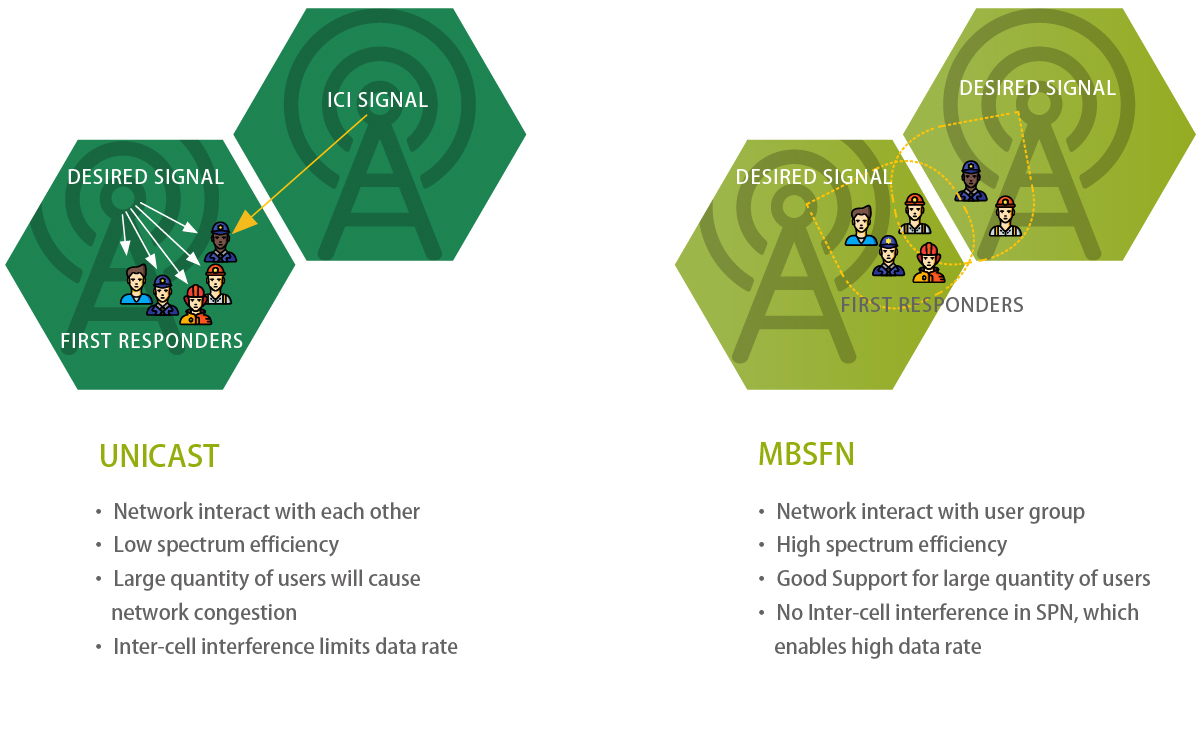
In addition, the use of eMBMS is crucial for the users who need to deal with large-scale events, especially in public safety. For example, when a large-scale event occurs, a large number of users will flood into the network. The number of users that the network can support is closely related to the network capacity. If the data stream is 1 Mbps for each user, a unicast system must support 80 Mbps totally for 80 users. While in an eMBMS system a single 1 Mbps stream would be enough for all users simultaneously, thus allowing more capacity in the cell for other users.
2.2 Hytera eMBMS Characteristics
Besides regular eMBMS functionalities, Hytera eMBMS supports the following features to bear MC (Mission Critical) services better.
Dynamic MBSFN area configuration
MCE will create MBSFN areas dynamically according to the demand of MC server, therefore ensure the coverage area for MC services.
Dynamic MBSFN subframe allocation
MCE will configure the proportion of M-subframe in one radio frame according to the requirement of real-time session, for example, Time of MBMS Data transfer, QCI, PDB, BLER and ARP. The dynamic allocation can avoid waste of radio resource compare to fixed M-subframe allocation.
New QCI for MC services
Dedicated QCIs for MC services are supported in both unicast and multicast to guarantee QoS and service continuity of MCS during uni / multicast switch and dynamic MBSFN area / subframe configuration.
Network TTI level SYNC solution
eMBMS synchronization implementations use both satellite-based GPS and synchronized back-haul protocols IEEE 1588, with a TTI level precision over the entire MBSFN area. The forward compatible design with Rel-14 can reduce the latency of data buffering to better protect the integrity of transmitted data, which leads to a better user experience.
Centralized and distributed MCE
Hytera eMBMS is capable of supporting either centralized (as an EPC element or in an independent hardware) or distributed MCE deployment according to various deployment requirement of mission critical networks.
Hytera MCS Broadband Trunking Solution
Hytera MCS broadband trunking solution, integrating MCPTT, MCVideo, MCData, is based on eMBMS technology. The solution consists of trunking terminals, eNB (evolved NodeB), EPC (Evolved Packet Core), MCS trunking server, network management system and dispatch applications. It features high QoS, low latency, backup and redundancy to better secure data and provides multiple trunking services, such as MCPTT calls, video group call, files distribution, late entry, DGNA and so on. Furthermore, MCS solution supports seamless interconnection with existing narrowband network. In MCPTT plugtest organized by the ETSI, Hytera MCS solution is proved to be capable of interconnecting with other 12 vendors.
3.1 Architecture
Hytera offers a comprehensive MCS solution including trunking terminals, LTE network, application and MCS parts based on eMBMS. The following figure shows the solution architecture.
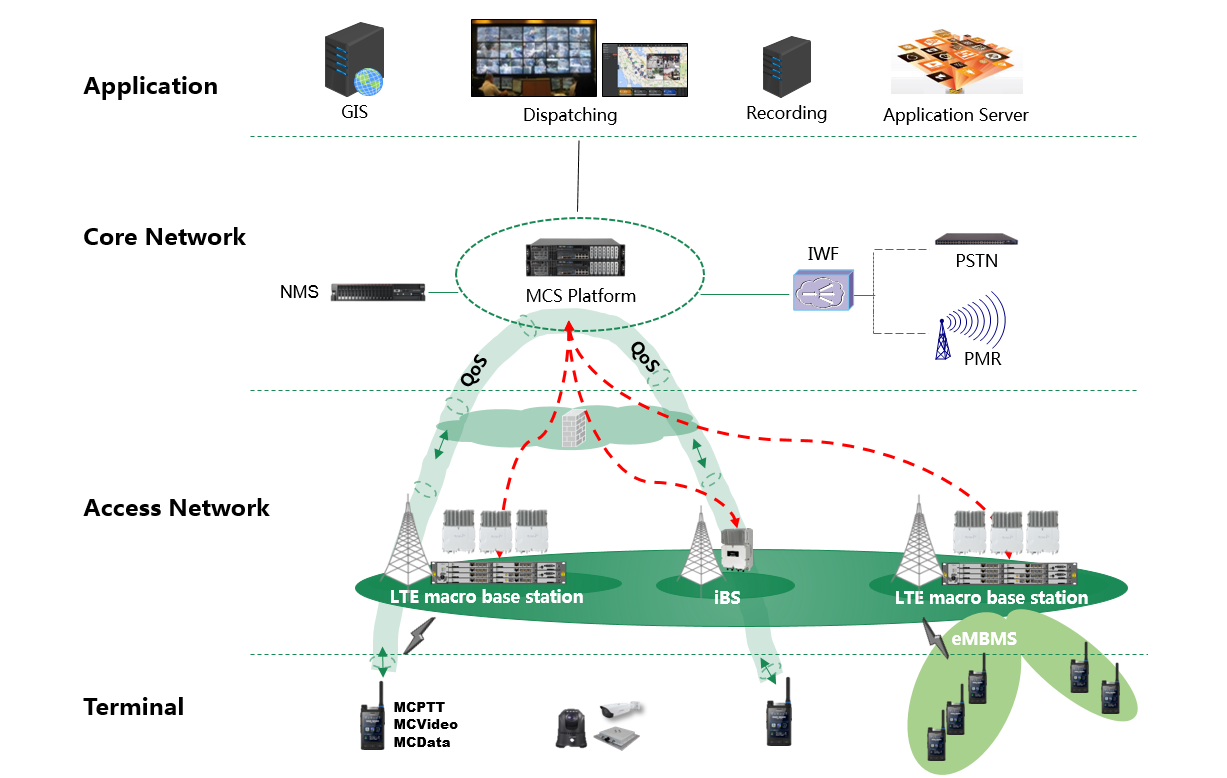
· MCS
MCS system includes MCS server and MCS app (named as MCC), NMS server/client are included to fulfill MCS services in group and user management. The MCS supports interconnection with legacy PMR systems and PSTN network.
· Application
Hytera developed various applications including dispatching, GIS, voice & video recording, and mobile device management system, etc.
· Network
Hytera LTE network includes eNB and EPC, which have telecommunication-level capacity, performance and reliability. There are three forms such as macro station, the iBS and the rapid deployment system, which can meet all kinds of network construction needs of customers.
· Terminal
Hytera provides three kinds of handheld ruggedized terminals to support MCS and eMBMS: multi-mode radio, dual-mode radio, and smart LTE terminal. In addition, Hytera released an MCS app (MCC), which enables users to access the MCS system via smart phones.
From the terminals, the network system to the applications, Hytera provides industry customers with leading end-to-end broadband trunking solution.
3.2 Deployments
With the ever-changing demand of users and the continuous development of technologies, customers mainly focus on the following factors for mission-critical communications over LTE network:
· Spectrum
· Network security and reliability
· Manageable and controllable
· The cost and duration of construction, and the operation and maintenance cost
In response to different customer demands, there are three ways to deploy Hytera MCS solution: Dedicated, MVNO (Mobile Virtual Network Operator) and Overlap
Network1: Dedicated
This mode is for private network only. It uses proprietary spectrum resources and builds new LTE base stations for private networks. It also has its own core networks and MCS services:
· Full ownership and responsibility for the network elements, hardware and software.
· Full control over coverage and service prioritization
· Moderate to high TCO due to introduction of RAN sites
· Short to long time network deployment period
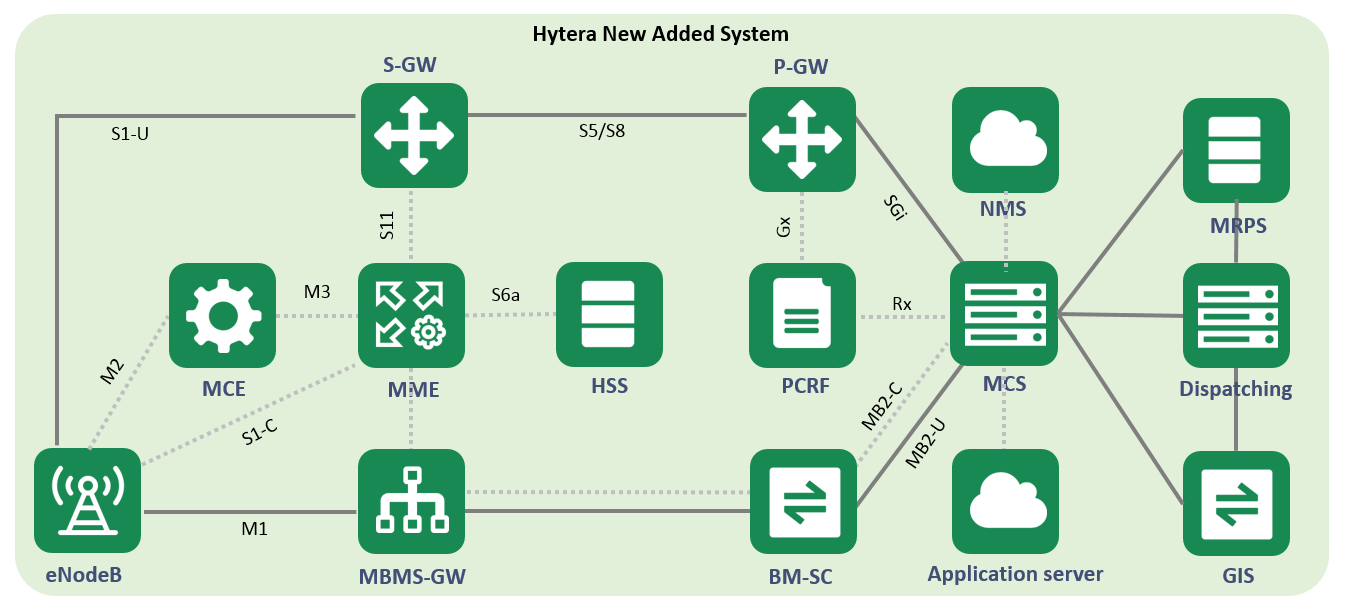
Network2: MVNO
MVNO mode utilizes operator's LTE network to enable fast and cost-efficient deployment of the MCS solution. It is also an innovative service to boost revenue for operator. Base stations and spectrum resources are shared among operators. There are two approaches of MVNO mode: MOCN and GWCN.
(1) Multi-Operator Core Network (MOCN):
With the MOCN approach, a dedicated core network for mission critical applications will be built. Base stations and spectrum resources are shared among operators.
· End-to-end service, prioritization and data security control
· User Data are all Controlled by Mission Critical Agencies
· Easy Deployment, Full Control Service Operation
· Moderate TCO compared with the aforementioned option
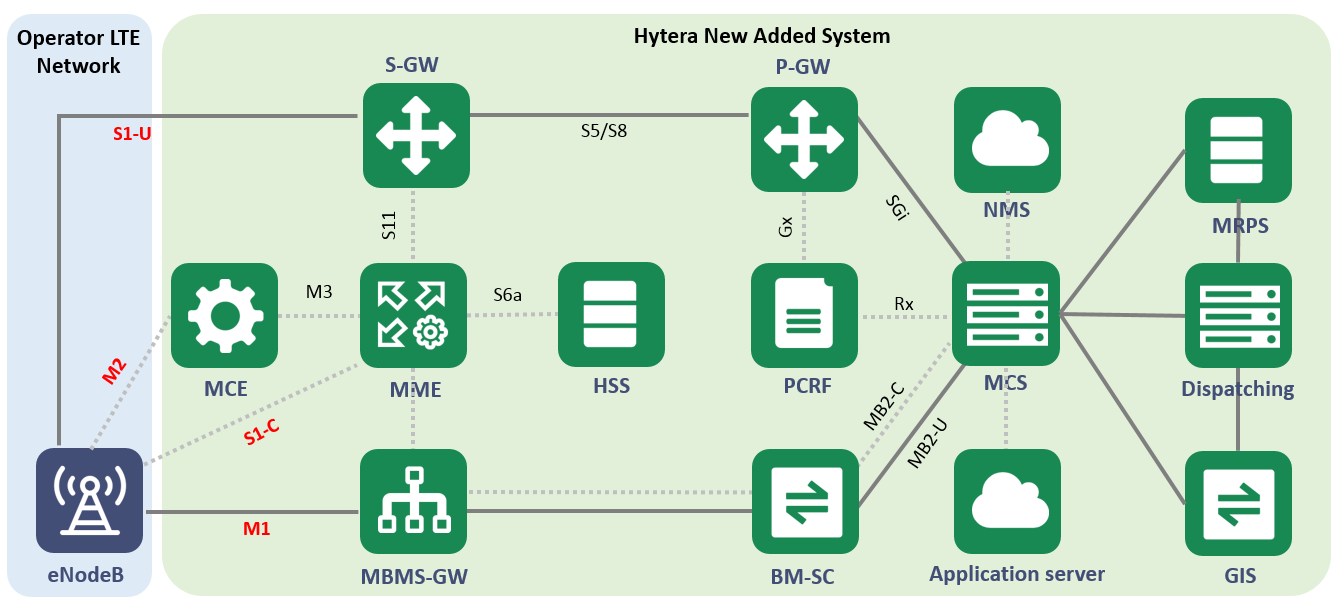
(2) Gateway Core Network (GWCN)
With the GWCN approach, MME and SGW are shared among MVNOs, while HSS, PGW, PCRF and MCS servers are dedicated.
· Lower Deployment Cost
· Easy Deployment, Controlled Service Operation
· Most of User Data Controlled by Mission Critical Agencies
· If it is necessary, Hytera can help operators upgrade current networks to meet the requirement of eMBMS by providing network entities MCE, MBMS-GW, BM-SC and related software packages.
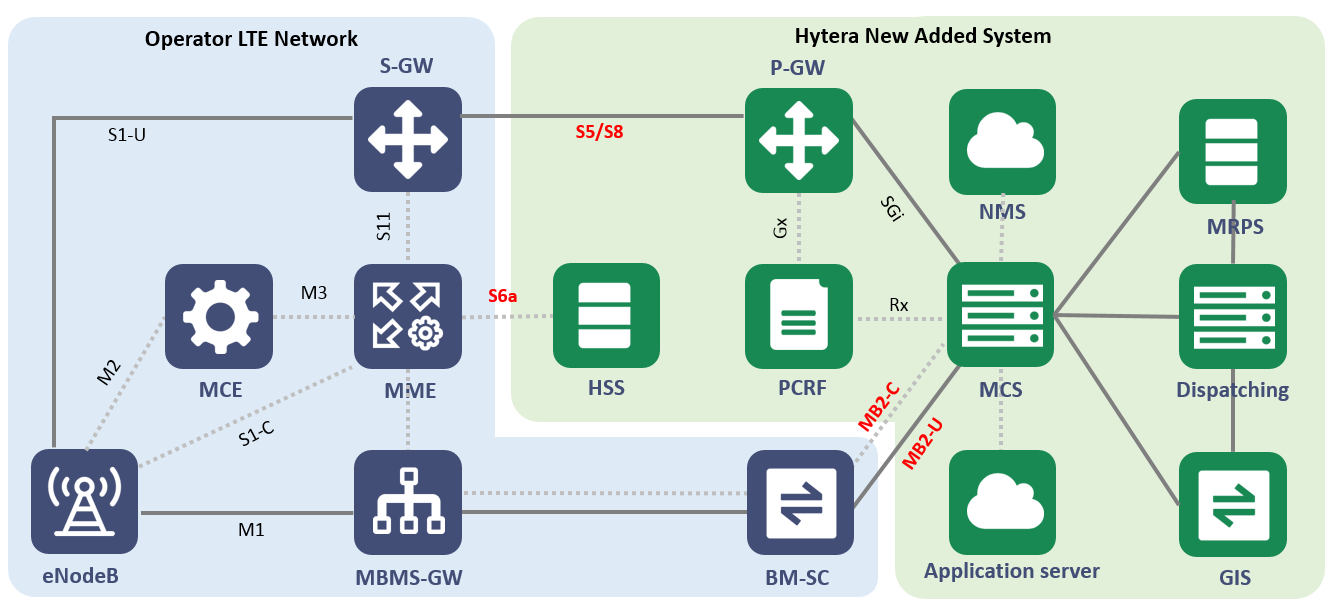
Network3: Overlap
This mode only requires newly-added MCS in the existing network. All users share the same core network. The overlap mode is easy to deploy and helps customers launch services quickly.
· Lowest Deployment Cost
· Easy Deployment & Operation
· Part of User Data Stored in Operator's System
· If it is necessary, Hytera can help operators upgrade current networks to meet the requirement of eMBMS by providing network entities MCE, MBMS-GW, BM-SC and related software packages.
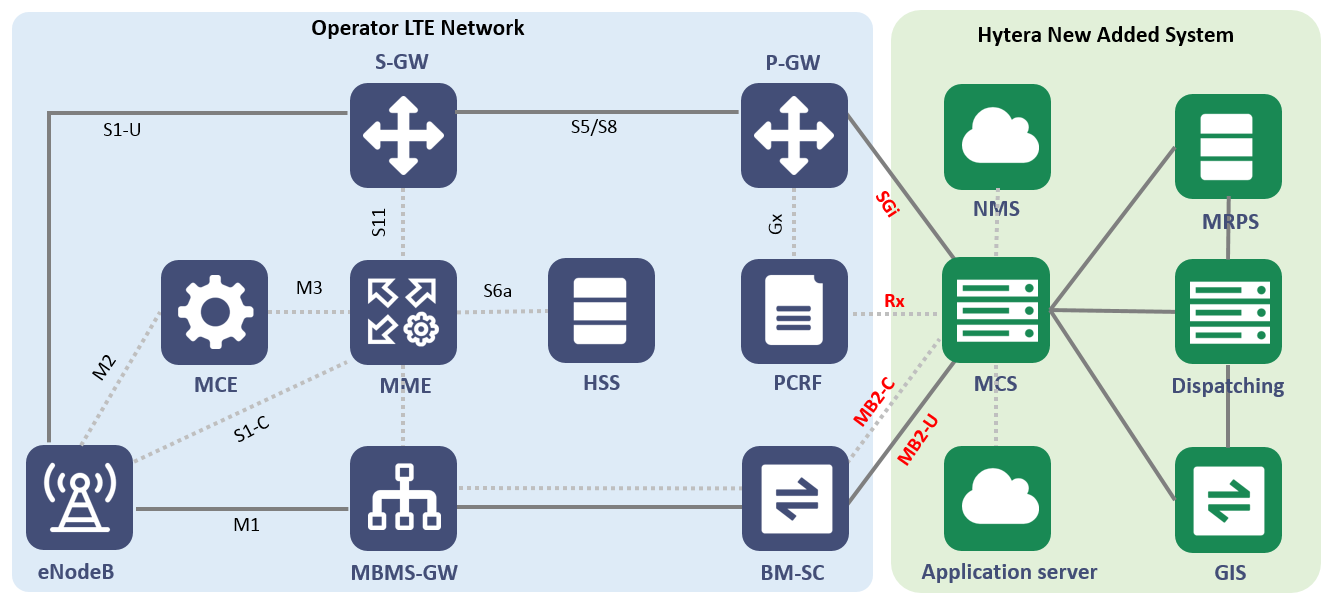
In conclusion, the comparison of benefits by considering spectrum, scalability, security, control, CAPEX, OPEX and delivery cycle, the deployments can be summarized as follows:

3.3 Highlights
Hytera MCS solution has the following highlights that benefit industry customers:
Standard Compliance
The MCS solution fully complies with 3GPP mission critical standard, including MCPTT, MC Video, and MC Data. It provides standard trunking services, such as voice call, video call, short message, multimedia message, etc.
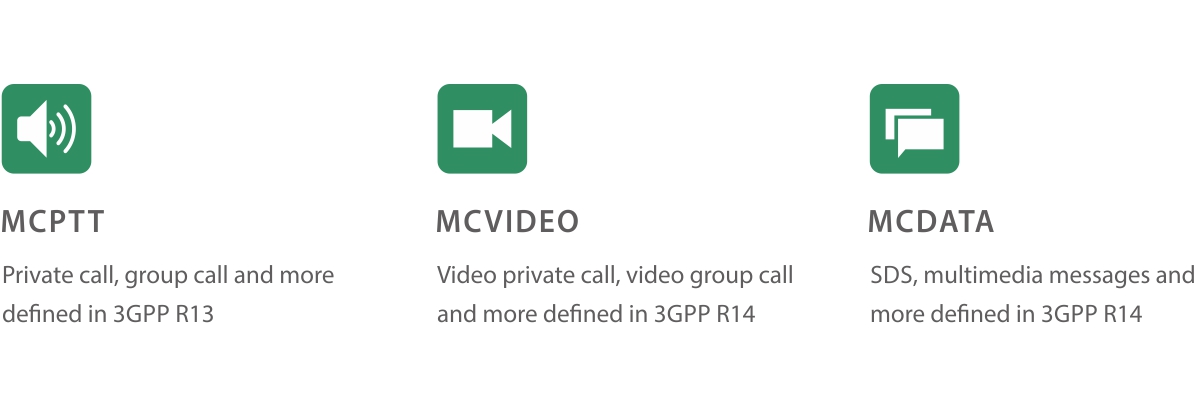
Professional Function & Performance
Abundant Trunking Service:The solution provides abundant trunking services, such as video push / pull, emergency call, imminent peril call, ambient listening, late entry, file distribution, stun / kill / revive , DGNA, GIS, voice & video recording, visualized dispatching, etc.
Professional Trunking Performance:Timeliness of data transmission is one of the key criteria for efficient dispatching. MCS solution provides professional performance with end-to-end transmission latency less than 50ms, call setup latency less than 500ms and preemption latency less than 300ms.
Multi-network Convergence
The MCS solution supports interoperability of multi-network and provides an all-around and unified communication experience. MCS can be deployed with any LTE network, including both private network and operator's public network. Through related gateways, MCS supports interworking with PSTN and PMR networks to extend coverage and reduce communication costs.

Security & Reliability
The MCS solution offers security by using both AS and NAS authentication, air-interface encryption, transmission link encryption (eg. IPSEC) and E2E encryption which uses AES (Advanced Encryption Standard) to encrypt the calls and videos to protect the users from interception and monitoring.
It also provides multi-level redundancy design, such as board-level backup, local & geographic redundancy, which can switch automatically when fault occurs, and IOPS (Isolated E-UTRAN Operation for Public Safety) to ensure stable and reliable operation of the network. With the IOPS, when the backhaul between eNB and EPC disconnect, or all the common core networks fail, the eNB will connect the sink core network and provide trunking service such as private / group call, data transmission for the users under this eNB.
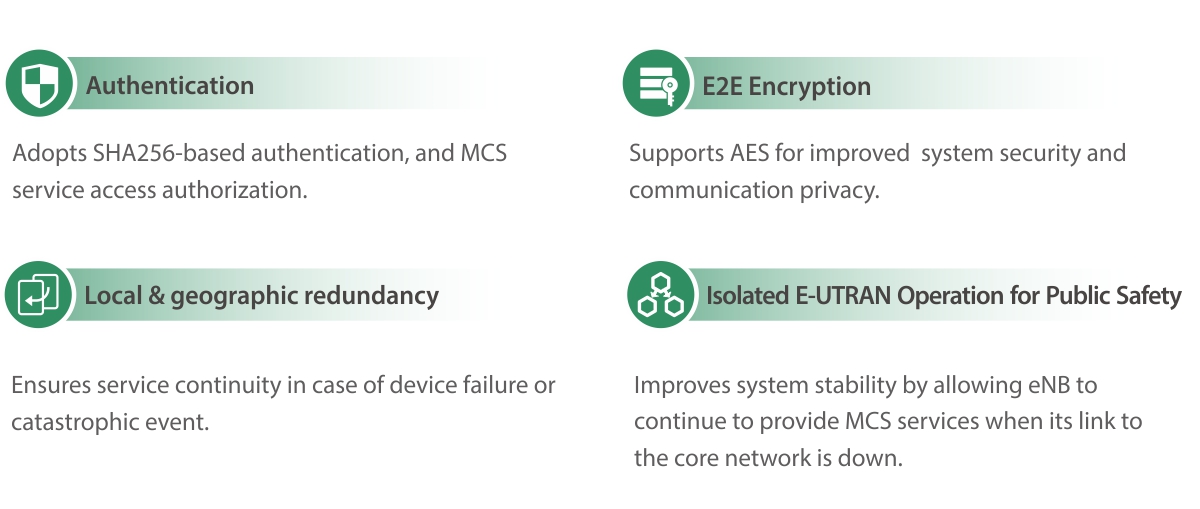
What's more, the solution provides high protection level trunking terminal and base station products, which can adapt to harsh environments. The trunking terminal supports ingress protection rating of IP68, which can work normally in heavy rain and are sturdy and durable with the support of MIL-STD-810 G standard. The base station is designed to support all outdoor work, no need for machine room, just power on and use; Ingress protection rating of IP67, shockproof rating above 9 magnitude, which can work normally under extreme temperature.
Superior User Experience
The MCS solution features high QoS guarantee, providing MCS service with the highest priority and reduced latency. Particularly eMBMS will improve communication efficiency. Multi-channel service concurrency makes users never miss any calls. It also provides unified dispatcher and unified NMS which dispatches service across various networks and manage both broadband and narrowband systems.
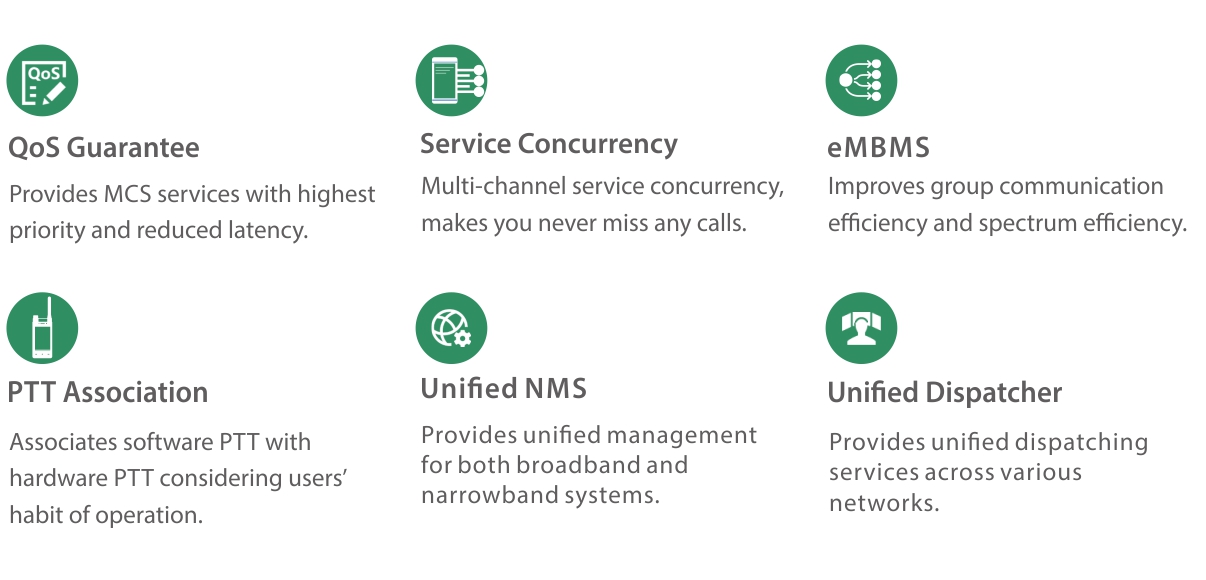
The solution associates software PTT with hardware PTT on trunking terminals. It considers the user's operation habits, and use audio technologies such as noise suppression, scream prevention, echo cancellation, mute detection and video technologies such as video retransmission, video buffering to improve user experience.
Besides, The solution has three forms of base stations, including macro station, the iBS and the rapid deployment, which is flexible to deploy.
Hytera MCS solution can be customized to meet the customer's needs for pure broadband communications, as well as narrowband-broadband converged communications. Smooth upgrade based on the customers' current network construction makes it possible to protect the customers' existing investment, and quickly implement high-speed data and video multimedia trunking services without affecting the key voice communication services.
3.4 Industry Application
With its diversified services, Hytera MCS broadband trunking solution is ideal for multiple mission critical fields, including public safety, utilities, transportation and energy.

Summary
Hytera, as a global leading provider of professional and private wireless communication equipment and solutions, has been committed to providing professional solutions for customers. Its eMBMS-based MCS broadband trunking solution provides large-scale group communication of voice, video services, high-traffic data transmission, and multimedia dispatching, ideal for multiple mission-critical fields, helping customers worldwide to achieve the impossible.





